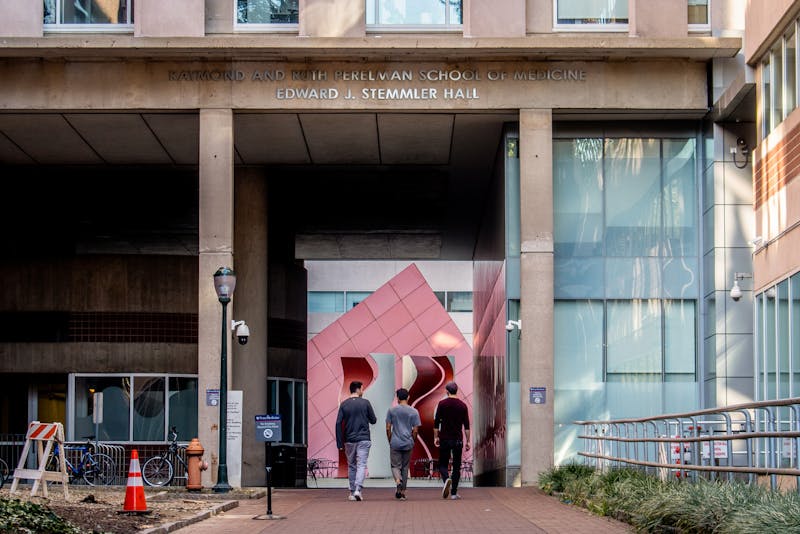
The return of in-person classes has meant many things for Penn's student body, most of them positive. However, one subgroup of students cannot always fully participate in on-campus activities. Last week, numerous students with physical disabilities reported accessibility problems on campus, such as with academic buildings, housing, and extracurriculars. This is not the first time the University's students with disabilities have felt excluded from campus culture, as students with disabilities such as autism and deafness have also reported challenges in navigating campus.
Under the 1990 Americans With Disabilities Act, various institutions, such as schools, are required to make reasonable accommodations for those with disabilities. Penn is legally compliant with the ADA; however, the students' reports are a worrying indication of how far the University is from being truly accessible. To combat systemic ableism, Penn must go beyond mere compliance with the ADA and do more to meet the needs of students with disabilities.
Despite the passage of the ADA over 30 years ago, individuals with disabilities often still struggle with systemic societal gaps, such as finding appropriate jobs, living in affordable and accessible housing, and disproportionate poverty and incarceration rates. Furthermore, the ADA itself is marred by questionable standards for accessibility and a lack of effective enforcement mechanisms. Penn did not write the ADA, nor did it write any other anti-discrimination law. However, that doesn't mean the University is isolated from America's problem of systemic ableism.
On campus, students with disabilities face a wide array of challenges — far too many for one editorial to capture. For example, students with impaired mobility are forced to grapple with outdated building designs and a flawed accessible transport system, both of which can hinder the ability of students with disabilities to navigate campus. Moreover, such challenges can extend outside of the classroom, with physical barriers existing in college houses and the Platt Performing Arts House. To compound ableism, students with disabilities who face invisible challenges, such as autistic people, can be left feeling invalided by peers, many of whom are well-intentioned yet fail to recognize their challenges.
Penn can take several steps to reduce systemic ableism on campus. First, the University should invest in creating inclusive infrastructure. Last week, the director of architecture and planning in the Office of the University Architect said there are no existing plans to modify on-campus buildings to promote accessibility. This is unacceptable. Penn students with disabilities have suggested a number of possible solutions for promoting on-campus inclusion, such as the upgrading of existing ramps, an increase in accessible entrances, the creation of on-campus spaces for students with disabilities, and designing indoor lecture spaces to reduce echos. Given the proliferation of multimillion-dollar construction projects on campus, Penn is likely able to afford relatively minor upgrades. Given this, the University must at least strongly consider the feasibility of such building changes.
Inclusion extends beyond the administration and the classroom. Students without disabilities must do more to help their peers, and include those with disabilities in their activism. Some of this is already occurring. For example, in 2019, the Penn Association for Gender Equity hosted a series of events surrounding "Body Reclamation Week” that included conversations regarding disability and ableism. While this is a good start, the University's student body needs more dialogue surrounding disability.
To promote such dialogue, Penn student groups should consider reaching out to disability umbrella organizations, such as the student group Disability Advocacy @ Penn, to gauge their interest in partnerships and co-hosting events. If and when the opportunity presents itself, the 6B, Penn's minority student group coalition, should consider adding a disability affinity group. Doing so would send a strong positive message to the disabled community at Penn, one regarding inclusion and understanding. Moreover, it would strengthen solidarity between different historically oppressed groups.
None of this is to say the University doesn't care about helping students with disabilities. On the contrary, not only is the University ADA compliant, but certain subgroups of the disabled community, such as deaf students, have praised Penn's flexibility and accommodations with regards to academics. Moreover, Penn was historically ahead of its Ivy League peers in promoting the study of American Sign Language on campus. However, it is important to recognize that students with disabilities face a wide variety of challenges, and Penn's response to ableism must reflect that.
Ableism often gets lost in conversations surrounding social justice. At Penn, this is more of the same. To prevent future instances of ableism, and to create a more inclusive campus for all, the University and its students must do more to address systemic ableism.
Editorials represent the majority view of members of The Daily Pennsylvanian, Inc. Editorial Board, which meets regularly to discuss issues relevant to Penn's campus. Participants in these meetings are not involved in the reporting of articles on related topics.
The Daily Pennsylvanian is an independent, student-run newspaper. Please consider making a donation to support the coverage that shapes the University. Your generosity ensures a future of strong journalism at Penn.
Donate







